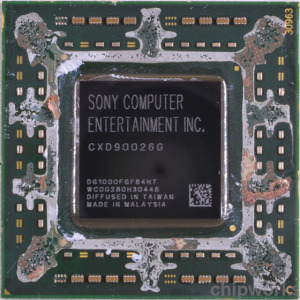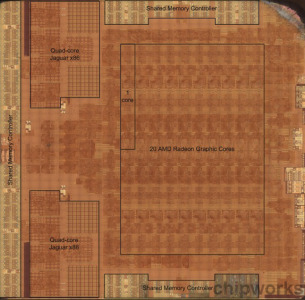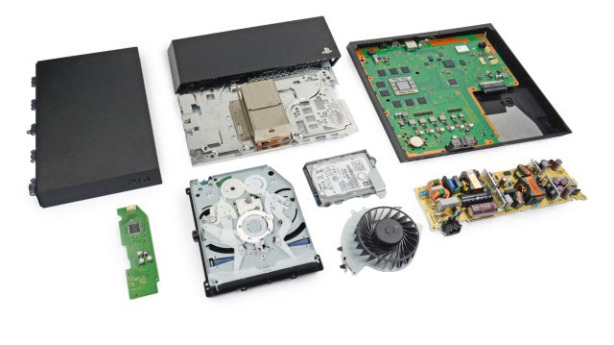
PlayStation 4 - Architecture and Performance
In most respects, the PS4 architecture isn’t that different from what you’d get on a low-end to mid-range gaming PC. It’s based on a custom 1.6GHz AMD APU combining two quad-core Jaguar CPU modules with a custom Radeon GPU. There are some minor architectural changes, but this is broadly similar to the Pitcairn architecture found in the Radeon HD 7870, running at 800Mhz with 18 GCN Compute Units and 1152 shaders.This makes the PS4 more powerful than the Xbox One, with its identical CPU but a smaller GPU with 12 Compute Units and 768 shaders, even though the Xbox One’s APU is clocked higher at 1.75Ghz CPU and 853MHz GPU. Still, it’s not particularly beefy by PC standards. After all, AMD’s Jaguar-based Kabini APUs aren’t exactly giving Intel nightmares on the raw performance front, while the HD 7870 is nothing more than a very solid mid-range GPU, from last year.
However, there are other factors at work here. Firstly, PS4 doesn’t have to run a full operating system, just a streamlined OS designed to support games using an enhanced DirectX 11 with Sony knobs on, Open GL 4.0 or a PS4-specific low-level API. Secondly, there are minor architectural differences in the make-up of the CPUs and GPU. Finally, while the PS4 has 8GB of RAM shared between CPU and GPU, it isn’t reliant on DDR3 memory but on high-speed GDDR5. This promises 176GB/sec bandwidth between the APU and RAM, which should help keep big textures and large data workloads running smoothly through the system.
We’re in the very early stages of a new console lifecycle – notoriously the worst time to make any judgements on a console’s power – but there’s reason to be impressed with PS4. Cross-platform titles like Call of Duty: Ghosts and Assassin’s Creed 4: Black Flag run smoothly (well, mostly smoothly in the case of Ghosts) at 1080p with the kind of effects, high-resolution textures and high detail levels you’d see were the game running on a good mid-range gaming PC. Battlefield 4 runs at 1600 x 900 in something very close to the PC’s High setting at 60fps; not quite 1080p, but close enough on a TV screen five feet away.
Those of you packing high-end gaming rigs with Core i7 CPUs and Radeon R9 290X or GTX 780 GPUs might want to sneer, but remember that this is a console targeting mainstream consumers, rolling out at just £349: barely enough to buy a decent CPU and GPU, let alone the motherboard, storage and RAM needed to support them. And the advantage of a fixed hardware platform is that developers will keep finding ways to get more out of it. You only need to look at what Naughty Dog and Quantic Dream achieved with The Last of Us and Beyond: Two Souls to see what can be done with the ancient, underpowered hardware of the PS3. With Killzone: Shadow Fall, Guerilla Games have already demonstrated what the PS4 can do with new lighting models, simulated materials and atmospheric effects, creating a game that can challenge Crysis 3 for the graphics crown. This is just a start; there’s a lot more power to be squeezed out of the new console.

MSI MPG Velox 100R Chassis Review
October 14 2021 | 15:04












Want to comment? Please log in.